Investigation of Indirect Shear Strength of Black Shale for Urban Deep Excavation
Abstract
:1. Introduction
2. Elastic Equilibrium of Anisotropic Medium
3. Materials and Methods
3.1. Properties of Black Shale
3.2. Uniaxial Compression Test
3.3. Indirect Tensile Strength (Brazilian Test)
4. Results and Discussions
4.1. Results of Uniaxial Compression Test
4.2. Results of Brazilian Test
4.3. Elastic Constants of Transversal Isotropic Materials
4.4. Stress Concentration Coefficients of Transversal Isotropic Material
4.5. Determination of Indirect Shear (Tensile) Strength of Black Shale
5. Conclusions
- As a result of this study, the five elastic constants (E, E’, ν, ν’, and G’) of black shale were successfully determined using uniaxial compression and Brazilian tests. It was observed that these constants vary significantly with the orientation of the shale’s anisotropic planes. For instance, Young’s modulus at 50% of the failure load was found to be highest in the 90° samples (average of 38.4 GPa) and lowest in the 45° samples (average of 12.7 GPa). The Poisson’s ratio was highest for the 90° samples (0.26) and lowest for the 0° samples (0.19). These results highlight the pronounced impact of anisotropy on rock’s mechanical behavior.
- The stress concentration coefficients for black shale were evaluated as differing from those of isotropic materials, depending on the inclination angle of the bedding planes. For example, at 0°, the stress concentration coefficient (ζxx) was approximately −2.33, while at 90°, it was about −1.34. The numerical analysis using the Finite Element Method (FEM) provided results consistent with the experimental observations, further validating the approach used in this study.
- The indirect tensile strength of black shale, as evaluated by the Brazilian test, decreased significantly as the inclination angle increased. At 0°, the tensile strength was approximately 17 MPa, but it decreased sharply to about 12 MPa at 15° and further declined to around 5 MPa at 90°. This trend underscores the significant influence of anisotropy on the tensile properties of rock, with the lowest tensile strength observed at an inclination angle of 90°.
- Both the experimental and numerical methods demonstrated similar trends in tensile strength reduction with an increasing inclination angle, though slight differences in the absolute values were noted. The average tensile strength predicted by the numerical analysis was 10.64 MPa, slightly higher than the experimental average of 9.81 MPa.
- The findings of this study emphasize the importance of accounting for anisotropy when evaluating the mechanical properties of black shale, particularly in engineering projects involving underground structures. The significant variations in elastic constants and tensile strength with orientation indicate that accurate modeling of rock behavior is crucial for ensuring stability and safety in construction. The study’s results can contribute to more accurate predictions of rock behavior under stress, leading to improved stability and safety in construction projects.
Funding
Data Availability Statement
Conflicts of Interest
References
- Durgunoglu, H.T.; Keskin, H.B.; Kulac, H.F.; Ikiz, S.; Karadayilar, T. Performance of soil nailed walls based on case studies. In Proceedings of the 14th European Conference on Soil Mechanics and Geotechnical Engineering, Madrid, Spain, 23–28 September 2007; pp. 557–564. [Google Scholar]
- Pinto, A.; Pereira, A.; Villar, M. Deep excavation for the new central library of Lisbon. In Proceedings of the 14th European Conference on Soil Mechanics and Geotechnical Engineering, Madrid, Spain, 23–28 September 2007; pp. 623–628. [Google Scholar]
- Gastebled, O.J.; Baghery, S. 3D modelling of a deep excavation in a sloping site for the assessment of induced ground movements. In Proceedings of the 7th European Conference on Numerical Methods in Geotechnical Engineering, NUMGE 2010, Trondheim, Norway, 2–6 June 2010. [Google Scholar]
- Tan, Y.; Wang, D. Characteristics of a large-scale deep foundation pit excavated by the central-island technique in Shanghai soft clay. I: Bottom-up construction of the central cylindrical shaft. J. Geotech. Geoenviron. Eng. 2013, 139, 1875–1893. [Google Scholar] [CrossRef]
- Masini, L.; Gaudio, D.; Rampello, S.; Romani, E. Observed performance of a deep excavation in the historical center of Rome. J. Geotech. Geoenviron. Eng. 2021, 147, 05020015. [Google Scholar] [CrossRef]
- Nguyen, T.S.; Likitlersuang, S. Influence of the spatial variability of soil shear strength on deep excavation: A case study of a Bangkok underground MRT station. Int. J. Geomech. 2021, 21, 04020248. [Google Scholar] [CrossRef]
- Tan, Y.; Fan, D.; Lu, Y. Statistical analyses on a database of deep excavations in Shanghai soft clays in China from 1995–2018. Pract. Period. Struct. Des. Const. 2022, 27, 04021067. [Google Scholar] [CrossRef]
- Seo, S.Y.; Lee, B.; Won, J. Comparative analysis of economic impacts of sustainable vertical extension methods for existing underground spaces. Sustainability 2020, 12, 975. [Google Scholar] [CrossRef]
- Lin, D.; Broere, W.; Cui, J. Underground space utilisation and new town development: Experiences, lessons and implications. Tunn. Undergr. Space Technol. 2022, 119, 104204. [Google Scholar] [CrossRef]
- Goodman, R.E.; Duncan, J.M. The role of structure and solid mechanics in the design of surface and underground excavations in rock. In Proceedings of the Civil Engineering Materials Conference, Structure Solid Mechanics and Design, Southampton, UK, 21–25 April 1969. [Google Scholar]
- Wang, X.; Zhen, F.; Huang, X.; Zhang, M.; Liu, Z. Factors influencing the development potential of urban underground space: Structural equation model approach. Tunn. Undergr. Space Technol. 2013, 38, 235–243. [Google Scholar] [CrossRef]
- Cui, J.; Nelson, J.D. Underground transport: An overview. Tunn. Undergr. Space Technol. 2019, 87, 122–126. [Google Scholar] [CrossRef]
- Lombardi, G. The influence of rock characteristics on the stability of rock cavities. Tun. Tun. Int. 1970, 2, 19–22. [Google Scholar]
- Ferrill, D.A.; Morris, A.P.; McGinnis, R.N.; Smart, K.J.; Wigginton, S.S.; Hill, N.J. Mechanical stratigraphy and normal faulting. J. Struct. Geol. 2017, 94, 275–302. [Google Scholar] [CrossRef]
- Schon, J.H. Physical Properties of Rocks: Fundamentals and Principles of Petrophysics, 2nd ed.; Elsevier: Amsterdam, The Netherlands, 2015. [Google Scholar]
- Wood, D.S.; Oertel, G.; Singh, J.; Bennett, H.F. A discussion on natural strain and geological structure-Strain and anisotropy in rocks. Philos. Trans. R. Soc. Lond. Ser. A-Math. Phys. Eng. Sci. 1976, 283, 27–42. [Google Scholar] [CrossRef]
- Amadei, B. Importance of anisotropy when estimating and measuring in situ stresses in rock. Int. J. Rock Mech. Min. Sci. 1996, 33, 293–325. [Google Scholar] [CrossRef]
- Abbass, H.A.; Mohamed, Z.; Yasir, S.F. A review of methods, techniques and approaches on investigation of rock anisotropy. In Proceedings of the Advances in Civil Engineering and Science Technology, Penang, Malaysia, 5–8 September 2018; AIP Publishing: Melville, NY, USA, 2018; Volume 2020, p. 020012. [Google Scholar] [CrossRef]
- He, M.; Wang, H.; Ma, C.; Zhang, Z.; Li, N. Evaluating the anisotropy of drilling mechanical characteristics of rock in the process of digital drilling. Rock Mech. Rock Eng. 2023, 56, 3659–3677. [Google Scholar] [CrossRef]
- Amadei, B. The Influence of Rock Anisotropy on Measurement of Stresses In Situ. Ph.D. Dissertation, University of California, Berkeley, CA, USA, 1982. [Google Scholar]
- Berenbaum, R.; Brodie, I. The tensile strength of coal. J. Inst. Fuel 1959, 32, 320–326. [Google Scholar]
- Hobbs, D.W. A simple method for assessing the uniaxial compressive strength of rock. Int. J. Rock Mech. Min. Sci. 1964, 1, 5–15. [Google Scholar] [CrossRef]
- McLamore, R.; Gray, K.E. The mechanical behavior of anisotropic sedimentary rocks. J. Manuf. Sci. Eng.-Trans. ASME. 1967, 89, 62–73. [Google Scholar] [CrossRef]
- Barla, G.; Innaurato, N. Indirect tensile testing of anisotropic rocks. Rock Mech. Rock Eng. 1973, 5, 215–230. [Google Scholar] [CrossRef]
- Hondros, G. The evaluation of Poisson’s ratio and the modulus of materials of a low tensile resistance by the Brazilian (indirect tensile) test with particular reference to concrete. Aust. J. Appl. Sci. 1959, 10, 243–264. [Google Scholar]
- Feng, G.; Kang, Y.; Wang, X.; Hu, Y.; Li, X. Investigation on the failure characteristics and fracture classification of shale under Brazilian test conditions. Rock Mech. Rock Eng. 2020, 53, 3325–3340. [Google Scholar] [CrossRef]
- Loureiro-Pinto, J. Determination of the elastic constants of anisotropic bodies by diametral compression test. In Proceedings of the 4th International Society for Rock Mechanics and Rock Engineering (ISRM) Congress, CONGRESS 79, Montreux, Switzerland, 2–8 September 1979. [Google Scholar]
- Amadei, B.; Rogers, J.D.; Goodman, R.E. Elastic constants and tensile strength of anisotropic rocks. In Proceedings of the 5th International Society for Rock Mechanics and Rock Engineering (ISRM) Congress, CONGRESS 83, Melbourne, Australia, 10–15 April 1983. [Google Scholar]
- Lempriere, B.M. Poisson’s ratios in orthotropic materials. AIAA J. 1968, 6, 2226–2227. [Google Scholar] [CrossRef]
- Chen, C.S. Characterization of Deformability, Strength, and Fracturing of Anisotropic Rocks Using Brazilian Test. Ph.D. Dissertation, University of Colorado, Boulder, CO, USA, 1996. [Google Scholar]
- Gabriele, G.A. Application of the Reduced Gradient Method to Optimal Engineering Design. Ph.D. Dissertation, Purdue University, West Lafayette, IN, USA, 1975. [Google Scholar]
- Pomeroy, C.D.; Morgans, W.T.A. The tensile strength of coal. Br. J. Appl. Phys. 1956, 7, 243–246. [Google Scholar] [CrossRef]
- Lekhnitskii, S.G. Anisotropic Plates, 2nd ed.; Gordon and Breach Science Publishers: New York, NY, USA, 1957. [Google Scholar]
- Amadei, B.; Jonsson, T. Tensile strength of anisotropic rocks measured with the splitting tension test. In Proceedings of the 12th Southeastern Conference Theoretical and Applied Mechanics, Pine Mountain, GA, USA, 10–11 May 1984. [Google Scholar]
- Chen, C.S.; Pan, E.; Amadei, B. Determination of deformability and tensile strength of anisotropic rock using Brazilian tests. Int. J. Rock Mech. Min. Sci. 1998, 35, 43–61. [Google Scholar] [CrossRef]
- Amadei, B.; Savage, W.Z.; Swolfs, H.S. Gravitational stresses in anisotropic rock masses. Int. J. Rock Mech. Min. Sci. 1987, 24, 5–14. [Google Scholar] [CrossRef]
- Sayers, C.M. The elastic anisotrophy of shales. J. Geophys. Res.-Solid Earth 1994, 99, 767–774. [Google Scholar] [CrossRef]
- Sondergeld, C.H.; Rai, C.S. Elastic anisotropy of shales. Leading Edge. 2011, 30, 324–331. [Google Scholar] [CrossRef]
- Sayers, C.M. The effect of anisotropy on the Young’s moduli and Poisson’s ratios of shales. Geophys. Prospect. 2013, 61, 416–426. [Google Scholar] [CrossRef]
- Islam, M.A.; Skalle, P. An experimental investigation of shale mechanical properties through drained and undrained test mechanisms. Rock Mech. Rock Eng. 2013, 46, 1391–1413. [Google Scholar] [CrossRef]
- Jin, Z.; Li, W.; Jin, C.; Hambleton, J.; Cusatis, G. Anisotropic elastic, strength, and fracture properties of Marcellus shale. Int. J. Rock Mech. Min. Sci. 2018, 109, 124–137. [Google Scholar] [CrossRef]
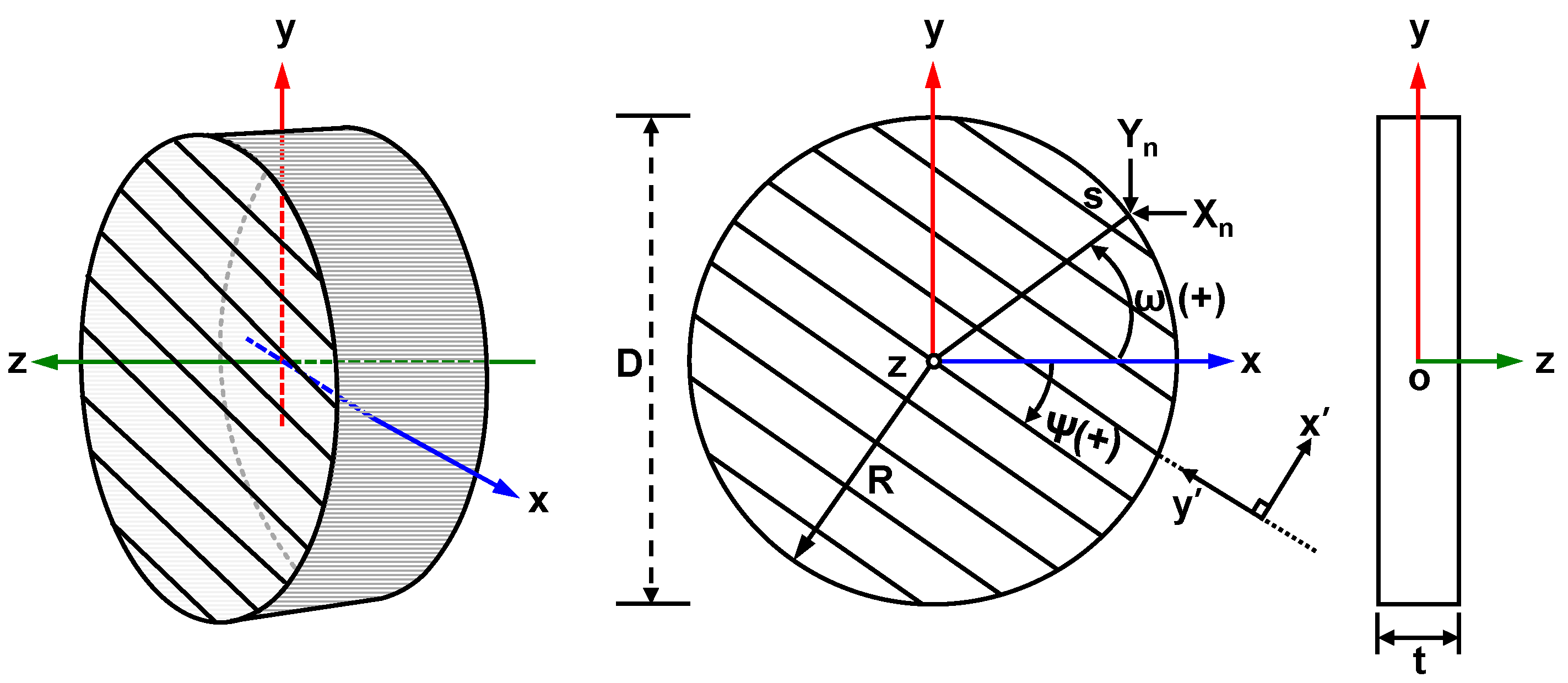
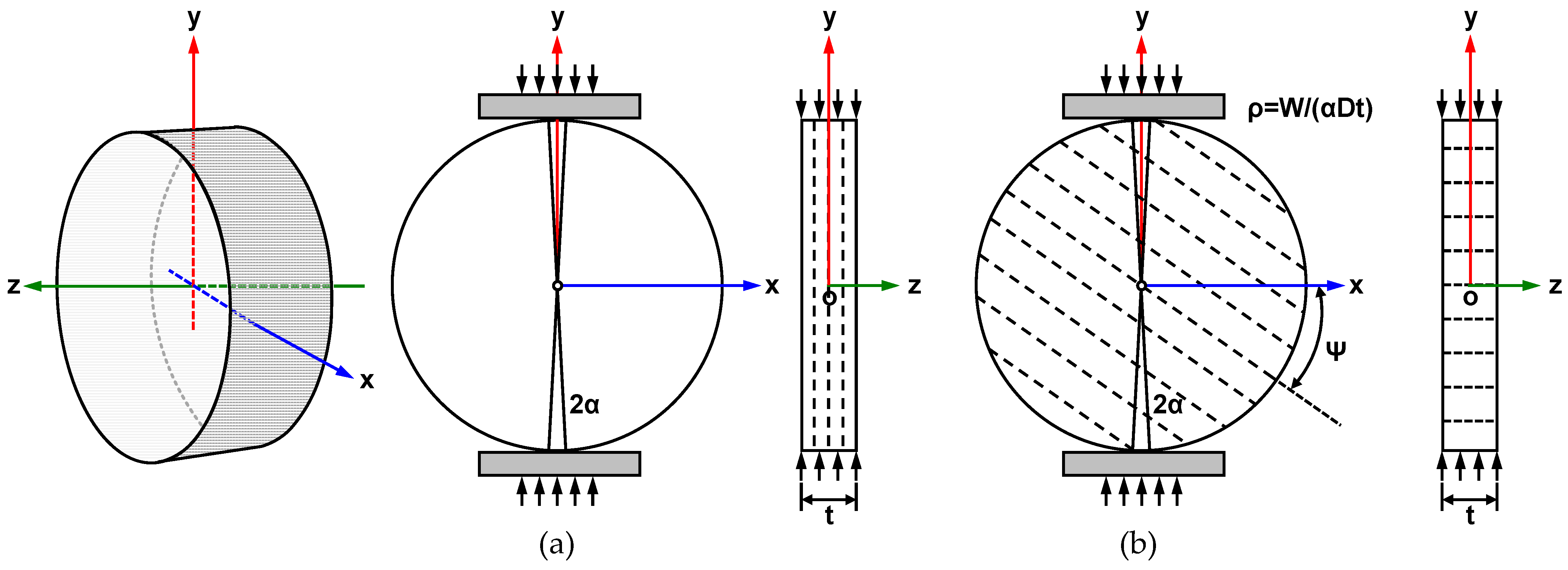
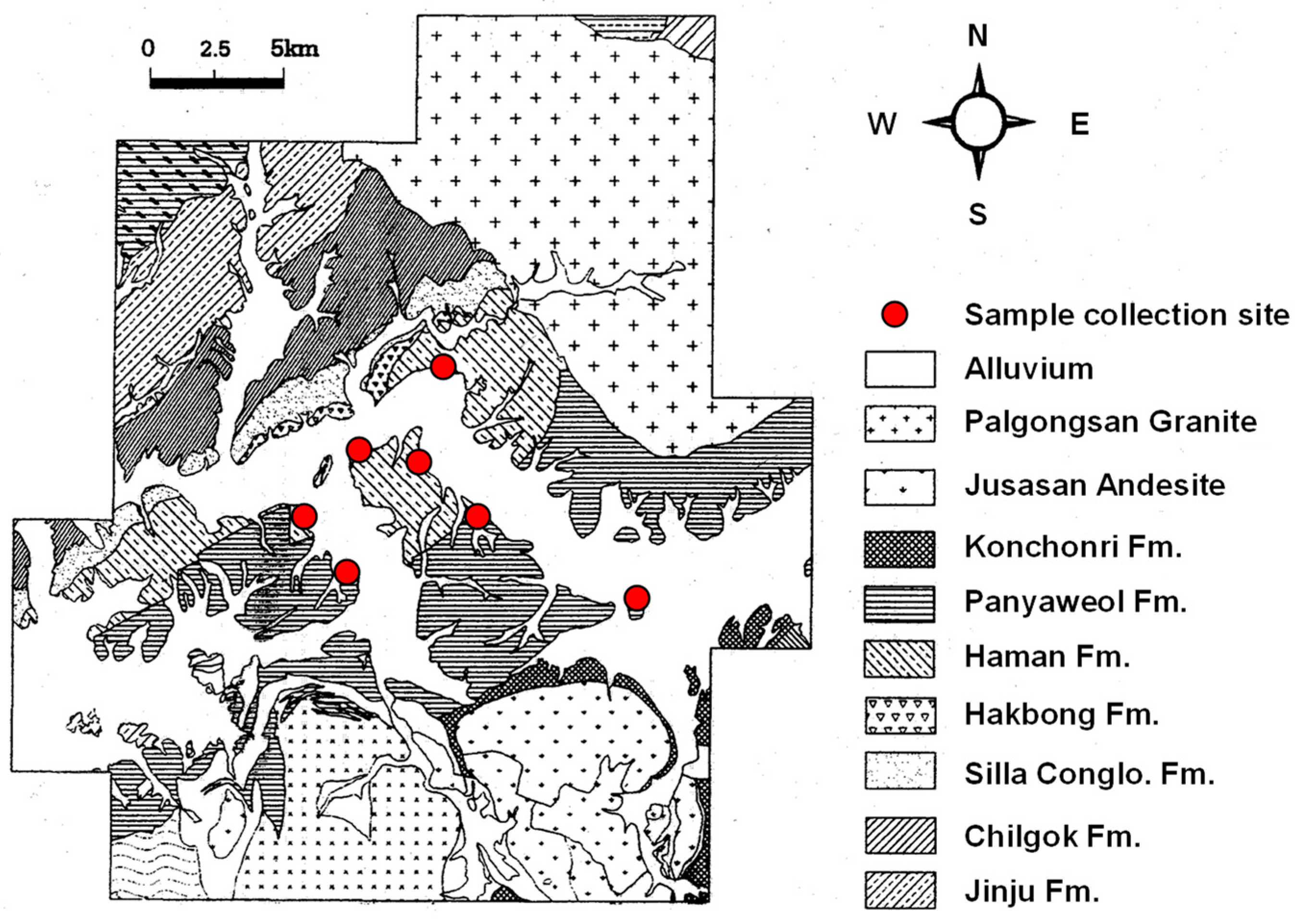


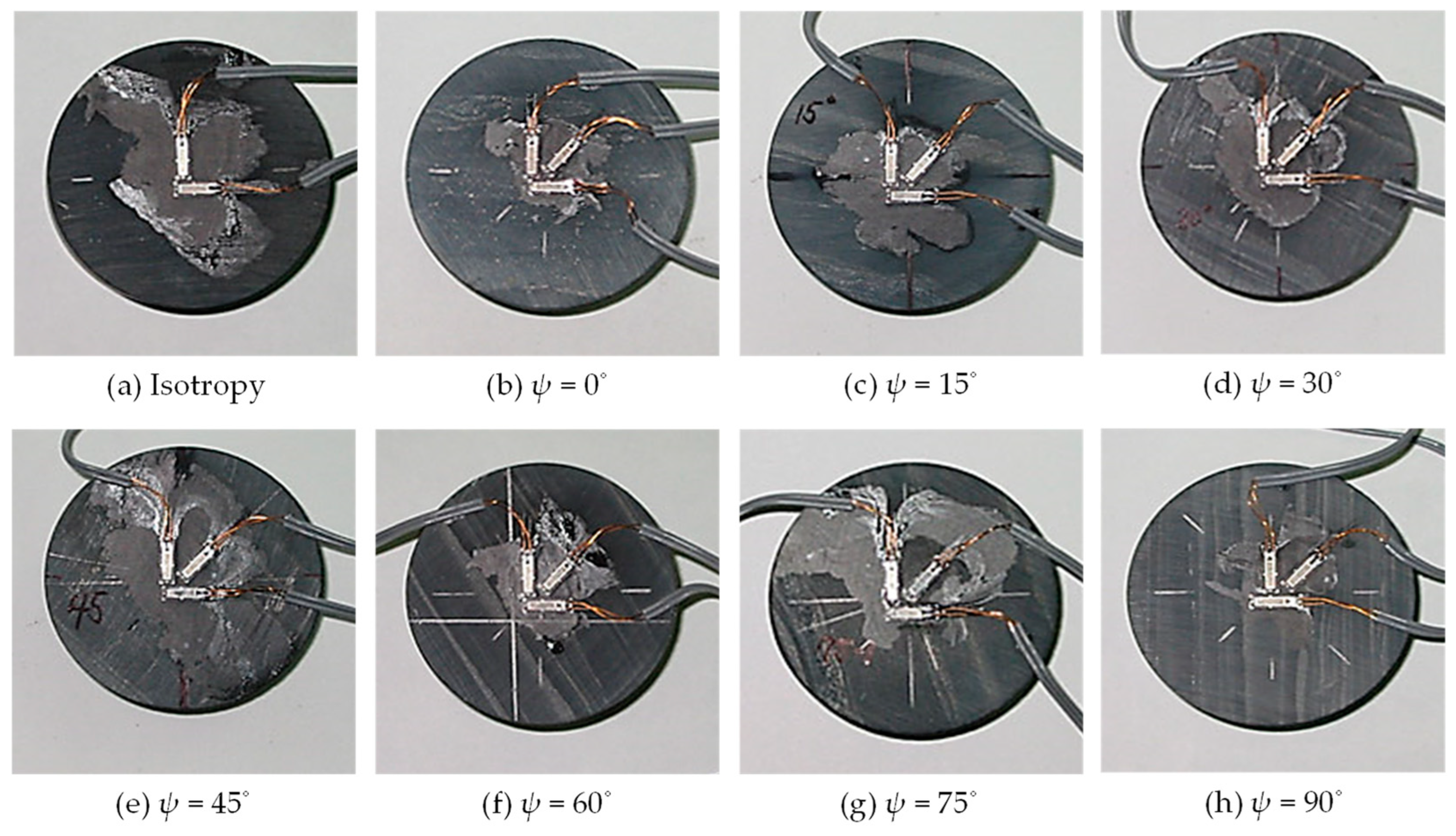



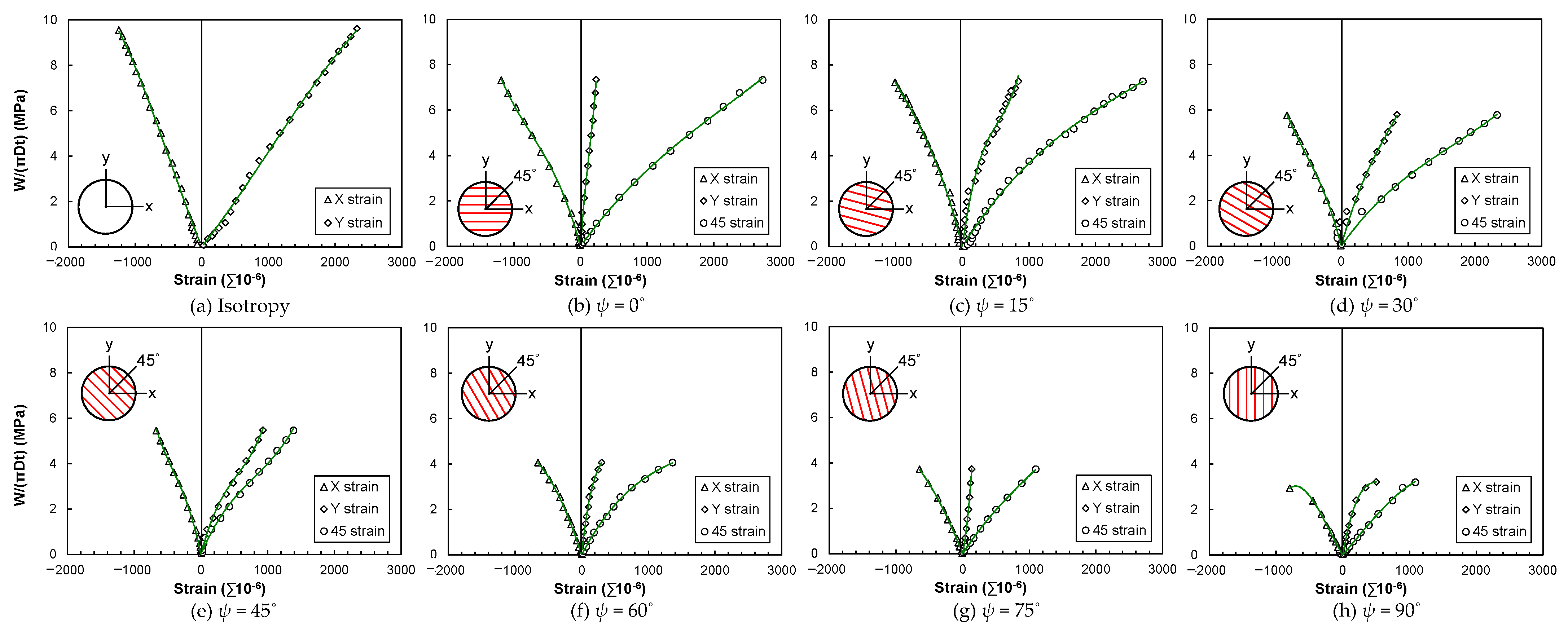


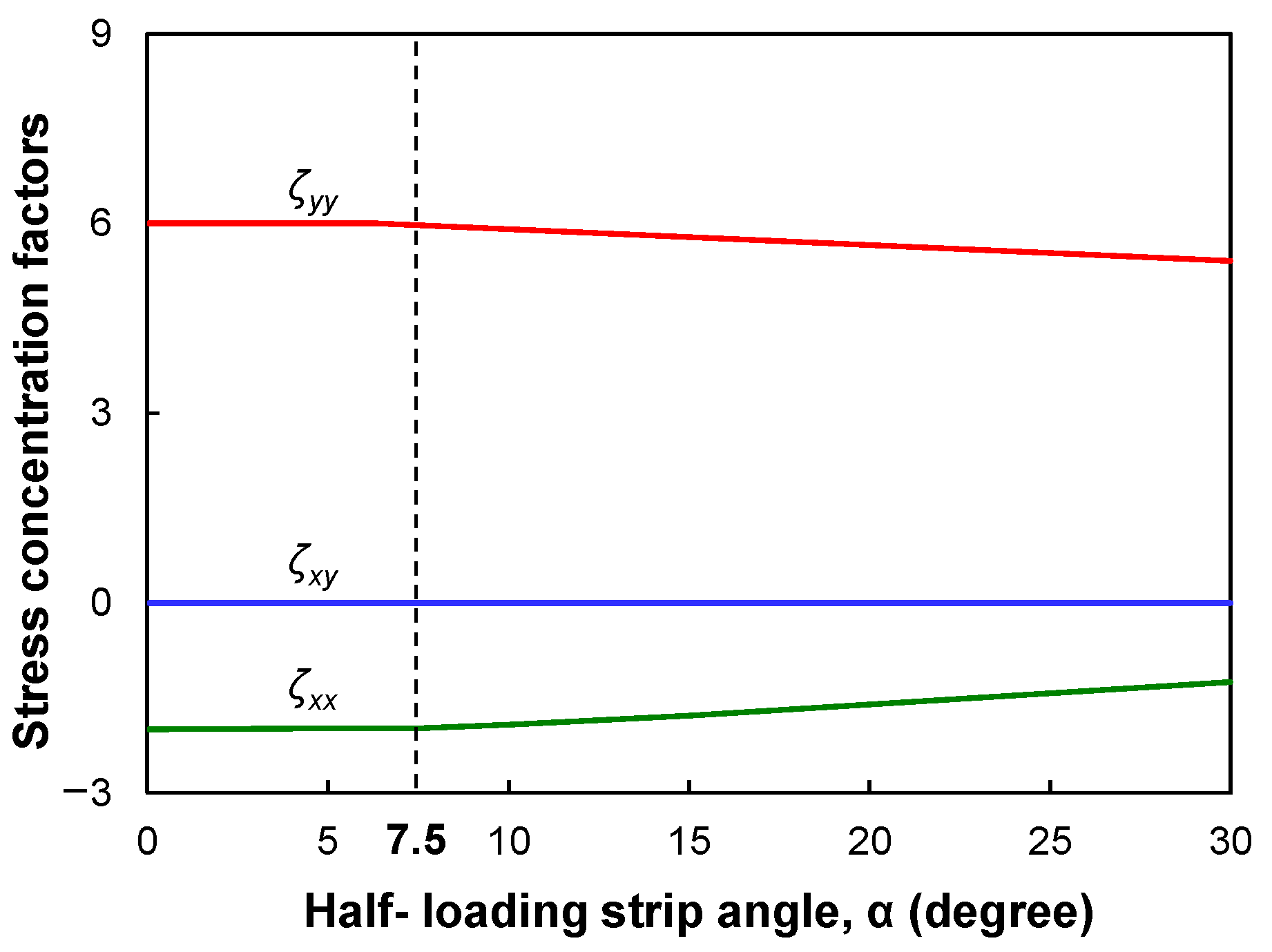
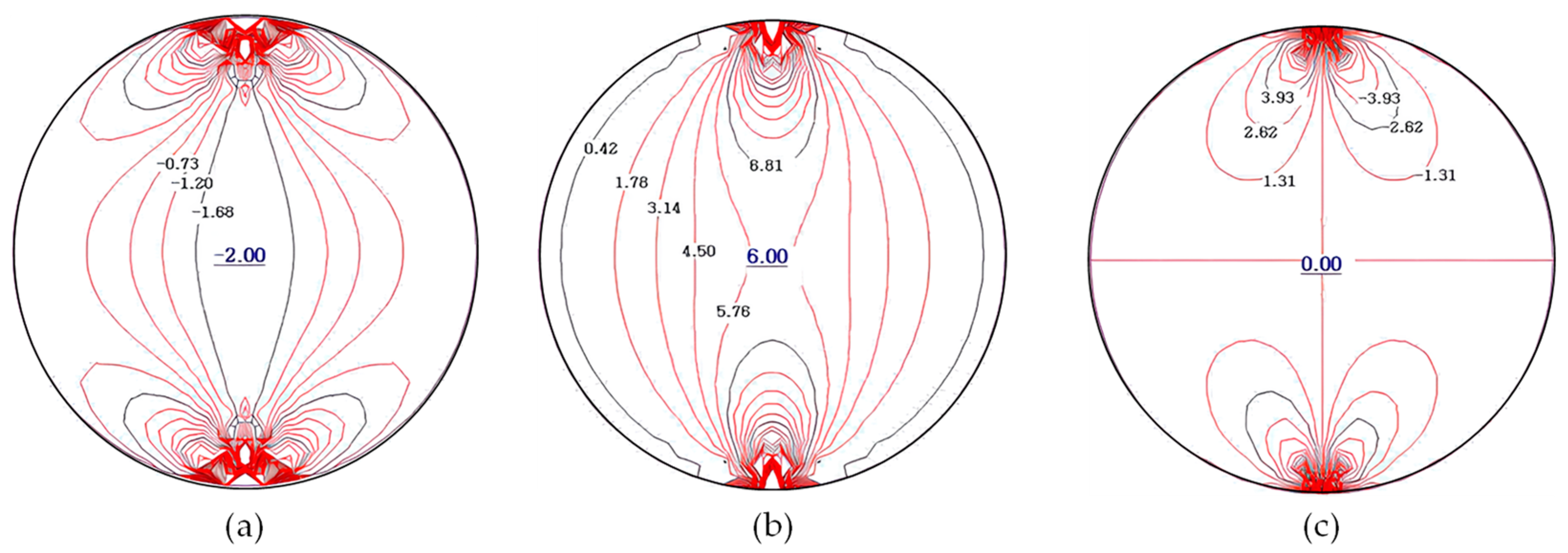


| Type | Sample No. | Natural State, Gn | Dry State, Gd | Saturated State, Gt | wn (%) | Sr (%) | ne (%) | ab (%) |
|---|---|---|---|---|---|---|---|---|
| Black shale | 1 | 2.743 | 2.739 | 2.746 | 0.16 | 59.57 | 0.75 | 0.27 |
| 2 | 2.742 | 2.724 | 2.745 | 0.65 | 72.65 | 2.13 | 0.78 | |
| 3 | 2.741 | 2.728 | 2.745 | 0.48 | 69.07 | 1.65 | 0.60 | |
| 4 | 2.742 | 2.736 | 2.745 | 0.20 | 62.22 | 0.89 | 0.33 | |
| 5 | 2.668 | 2.661 | 2.672 | 0.25 | 65.96 | 1.00 | 0.38 | |
| 6 | 2.674 | 2.647 | 2.680 | 0.30 | 79.65 | 3.34 | 0.26 | |
| 7 | 2.711 | 2.682 | 2.719 | 0.65 | 79.09 | 3.74 | 0.49 | |
| Average | 2.717 | 2.702 | 2.722 | 0.38 | 69.74 | 1.93 | 0.44 | |
| Sample | Component (%) | |||||||||
|---|---|---|---|---|---|---|---|---|---|---|
| Q | Or | Ab | An | Wo | Cm | Iim | Mt | Cc | Tn | |
| Black shale | 18.10 | 3.60 | 26.74 | - | - | 27.58 | 0.59 | 2.13 | 18.20 | 7.48 |
| Angle | Sample | Unconfined Compression Strength (MPa) | EY (GPa) | E (GPa) | ν | E′ (GPa) | ν′ | G (GPa) | G′ (GPa) |
|---|---|---|---|---|---|---|---|---|---|
| 0° | A | 89 | 14.16 | - | - | 14.16 | 0.21 | - | - |
| B | 86 | 15.44 | - | - | 15.44 | 0.14 | - | - | |
| C | 83 | 12.49 | - | - | 12.49 | 0.21 | - | - | |
| Average | 86 | 14.03 | - | - | 14.03 | 0.19 | - | - | |
| 45° | D | 60 | 14.53 | - | - | - | - | - | 10.63 |
| E | 57 | 11.69 | - | - | - | - | - | 8.09 | |
| F | 50 | 11.88 | - | - | - | - | - | 8.33 | |
| Average | 56 | 12.70 | - | - | - | - | - | 9.02 | |
| 90° | G | 75 | 27.25 | 30.77 | 0.27 | - | - | 11.24 | - |
| H | 69 | 28.89 | 33.30 | 0.24 | - | - | 12.64 | - | |
| I | 62 | 27.56 | 51.13 | 0.28 | - | - | 11.41 | - | |
| Average | 69 | 27.90 | 38.40 | 0.26 | - | - | 11.76 | - |
| Sample | D (mm) | t (mm) | εxπDt/W (MPa−1) | εyπDt/W (MPa−1) | E (GPa) | ν (-) | G (GPa) | Wf/πDt (MPa) |
|---|---|---|---|---|---|---|---|---|
| Isotropy | 54 | 26.5 | −1.18 | 2.27 | 4.97 | 0.533 | 1.62 | 9.61 |
| Sample | ψ (degree) | D (mm) | t (mm) | εxπDt/W (MPa−1) | ε45πDt/W (MPa−1) | εyπDt/W (MPa−1) | E′ (GPa) | ν′ (-) | G′ (GPa) | Wf/πDt (MPa) |
|---|---|---|---|---|---|---|---|---|---|---|
| A | 0° | 54 | 26.5 | −1.30 | 0.29 | 2.96 | 3.25 | 0.436 | 2.13 | 7.33 |
| 15° | 54 | 26.2 | −1.02 | 0.70 | 2.59 | 3.70 | 0.372 | 2.54 | 7.28 | |
| 30° | 54 | 24.2 | −1.14 | 1.04 | 3.17 | 3.22 | 0.348 | 2.24 | 5.77 | |
| 45° | 54 | 25.0 | −0.98 | 1.35 | 2.09 | 4.59 | 0.484 | 3.03 | 5.47 | |
| 60° | 54 | 27.2 | −1.20 | 0.41 | 2.09 | 4.60 | 0.481 | 2.62 | 4.06 | |
| 75° | 54 | 25.5 | −1.43 | 0.43 | 2.49 | 3.87 | 0.589 | 2.30 | 3.72 | |
| 90° | 54 | 26.1 | −1.59 | 0.60 | 2.76 | 3.22 | 0.730 | 1.98 | 3.21 |
| Test | E (GPa) | E′ (GPa) | ν (-) | ν′ (MPa) | G (GPa) | G′ (GPa) | E/E′ (-) | G/G′ (-) |
|---|---|---|---|---|---|---|---|---|
| Uniaxial comp. test | 38.40 | 14.03 | 0.260 | 0.190 | 11.76 | 9.02 | 2.737 | 1.304 |
| Brazilian test | 4.97 | 3.78 | 0.533 | 0.491 | 1.62 | 2.41 | 1.315 | 0.672 |
| Inclination Angle, ψ | Sample | Failure Stress (MPa) | Stress Concentration Coefficients | |||||
|---|---|---|---|---|---|---|---|---|
| Experimental Method | Numerical Method | |||||||
| ζ xx | ζ yy | ζ xy | ζ xx | ζ yy | ζ xy | |||
| Isotropy | A | 9.60 | −1.99 | - | - | −2.00 | 6.00 | 0.00 |
| B | 9.11 | −2.02 | - | - | ||||
| C | 9.15 | −1.96 | - | - | ||||
| Average | 9.30 | −1.99 | - | - | ||||
| 0° | A | 7.32 | −2.45 | 3.73 | 0.27 | −2.33 | 4.97 | 0.00 |
| B | 8.85 | −2.37 | 4.24 | 0.38 | ||||
| C | 5.58 | −2.18 | 5.30 | 0.54 | ||||
| Average | 7.25 | −2.33 | 4.42 | 0.40 | ||||
| 15° | A | 6.36 | −1.97 | 5.83 | 0.45 | −2.30 | 5.09 | −0.17 |
| B | 7.69 | −2.30 | 4.26 | 0.37 | ||||
| C | 6.44 | −2.10 | 4.87 | 0.71 | ||||
| Average | 6.83 | −2.12 | 4.99 | 0.51 | ||||
| 30° | A | 5.76 | −2.03 | 5.12 | 0.39 | −2.18 | 5.43 | −0.30 |
| B | 4.37 | −2.06 | 3.73 | 0.56 | ||||
| C | 4.75 | −2.27 | 4.99 | 0.35 | ||||
| Average | 4.96 | −2.12 | 4.61 | 0.43 | ||||
| 45° | A | 5.45 | −1.93 | 3.99 | 0.83 | −2.02 | 5.95 | −0.37 |
| B | 6.26 | −1.88 | 4.92 | 0.52 | ||||
| C | 4.57 | −1.84 | 5.13 | 0.42 | ||||
| Average | 5.42 | −1.88 | 4.68 | 0.59 | ||||
| 60° | A | 4.05 | −1.53 | 5.29 | 0.16 | −1.83 | 6.52 | −0.33 |
| B | 6.26 | −1.34 | 5.46 | 0.33 | ||||
| C | 4.71 | −1.51 | 3.65 | 0.39 | ||||
| Average | 5.01 | −1.46 | 4.8 | 0.29 | ||||
| 75° | A | 3.70 | −1.21 | 6.64 | 0.31 | −1.69 | 6.97 | −0.19 |
| B | 4.26 | −1.48 | 5.92 | 0.18 | ||||
| C | 4.08 | −1.55 | 5.64 | 0.52 | ||||
| Average | 4.02 | −1.41 | 6.07 | 0.34 | ||||
| 90° | A | 3.20 | −1.33 | 7.77 | 0.73 | −1.64 | 7.13 | 0.00 |
| B | 2.29 | −1.07 | 10.01 | 0.86 | ||||
| C | 2.10 | −1.61 | 6.03 | 1.38 | ||||
| Average | 2.53 | −1.34 | 7.94 | 0.99 | ||||
Disclaimer/Publisher’s Note: The statements, opinions and data contained in all publications are solely those of the individual author(s) and contributor(s) and not of MDPI and/or the editor(s). MDPI and/or the editor(s) disclaim responsibility for any injury to people or property resulting from any ideas, methods, instructions or products referred to in the content. |
© 2024 by the author. Licensee MDPI, Basel, Switzerland. This article is an open access article distributed under the terms and conditions of the Creative Commons Attribution (CC BY) license (https://creativecommons.org/licenses/by/4.0/).
Share and Cite
Kim, M. Investigation of Indirect Shear Strength of Black Shale for Urban Deep Excavation. Buildings 2024, 14, 3050. https://doi.org/10.3390/buildings14103050
Kim M. Investigation of Indirect Shear Strength of Black Shale for Urban Deep Excavation. Buildings. 2024; 14(10):3050. https://doi.org/10.3390/buildings14103050
Chicago/Turabian StyleKim, Mintae. 2024. "Investigation of Indirect Shear Strength of Black Shale for Urban Deep Excavation" Buildings 14, no. 10: 3050. https://doi.org/10.3390/buildings14103050






